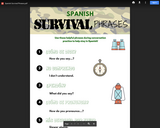
This handy sheet contains key "survival" phrases to assist students with staying in Spanish.
- Subject:
- Arts and Humanities
- Languages
- Material Type:
- Reading
- Author:
- Ashley Potzernitz
- Amber Hoye
- Date Added:
- 12/18/2018

This handy sheet contains key "survival" phrases to assist students with staying in Spanish.
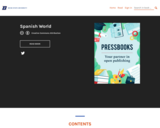
This course is an introduction to Spanish at a beginner level.
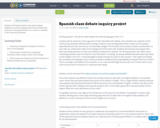
Students will debate whether they think making English our national language will solve problems that arise from a language divide in our country or whether it will create new problems.

Spanish for Bilingual Students is an intermediate course designed principally for heritage learners, but which includes other students interested in specific content areas, such as US Latino immigration, identity, ethnicity, education and representation in the media. Linguistic goals include vocabulary acquisition, improvement in writing, and enhancement of formal communicative skills.

This resource was designed for a beginning Spanish student, but its content can be useful (and adapted to) more advanced students.This online textbook is comprised entirely of free, open-educational resources which are available to anyone. These include SpanishDict.com, StudySpanish.com, The Spanish Experiment, YouTube and much more.The content is practical, authentic and engaging, but more importantly, it allows students to acquire much more than basic Spanish skills. The emphasis will be on oral communication and cultural understanding, but grammar and vocabulary building activities are also included in order to provide the student with a well-rounded experience equivalent to one semester of a college-level introductory Spanish course.

This resource was designed for a beginning-intermediate Spanish student, but its content can be useful (and adapted to) more advanced students. The equivalent of this resource would be a second-semester Spanish course. This online textbook resource is comprised entirely of free, open-educational resources which are available to anyone. These include SpanishDict.com, StudySpanish.com, The Spanish Experiment, YouTube and many more.The content is practical, authentic and engaging, but more importantly, it allows students to acquire much more than basic Spanish skills. The emphasis will be on oral communication and cultural understanding, but grammar and vocabulary building activities are also included in order to provide the student with a well-rounded experience equivalent to one semester of a college-level introductory Spanish course.

This resource was designed for a beginning-intermediate Spanish student, but its content can be useful (and adapted to) more advanced students. The equivalent of this resource would be a second-semester Spanish course. This online textbook resource is comprised entirely of free, open-educational resources which are available to anyone. These include SpanishDict.com, StudySpanish.com, The Spanish Experiment, YouTube and many more.The content is practical, authentic and engaging, but more importantly, it allows students to acquire much more than basic Spanish skills. The emphasis will be on oral communication and cultural understanding, but grammar and vocabulary building activities are also included in order to provide the student with a well-rounded experience equivalent to one semester of a college-level introductory Spanish course.

This online resource which is designed as a highly interactive alternative to a textbook for a full-semester course to help beginning students gain or increase Spanish skills that are useful for their career, daily life, academics and travel. The emphasis will be in language output for daily life and professional purposes, and there is very little emphasis on grammar as this will be acquired naturally through exposure to the language.Students will find activities to build speaking, listening, writing and reading skills as well as explore Spanish, Hispanic and Latin American culture.All sources in this resource are Open Educational Resources which are free and available to all users.

This online resource which is designed as a highly interactive alternative to a textbook for a full-semester course to help beginning students gain or increase Spanish skills that are useful for their career, daily life, academics and travel. The emphasis will be in language output for daily life and professional purposes, and there is very little emphasis on grammar as this will be acquired naturally through exposure to the language.Students will find activities to build speaking, listening, writing and reading skills as well as explore Spanish, Hispanic and Latin American culture.All sources in this resource are Open Educational Resources which are free and available to all users.

This online resource which is designed as a highly interactive alternative to a textbook for a full-semester course to help beginning students gain or increase Spanish skills that are useful for their career, daily life, academics and travel. The emphasis will be in language output for daily life and professional purposes, and there is very little emphasis on grammar as this will be acquired naturally through exposure to the language.Students will find activities to build speaking, listening, writing and reading skills as well as explore Spanish, Hispanic and Latin American culture.All sources in this resource are Open Educational Resources which are free and available to all users.

Full course in basic Spanish for use with clients, colleagues or employees in a variety of workplace environments. This one-semester (3-credit) course is approximately congruent with Spanish 101, but emphasizes communicative functions over grammar or extensive writing skills. Text includes topical vocabulary, instructional explanations, cultural information, and curated links to quality resources for practice.
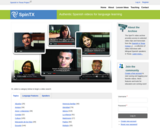
Authentic Spanish videos for language learning
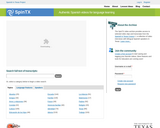
The SpinTX video archive provides a convenient web interface to search hundreds of short video clips from the Spanish in Texas Corpus. The collection includes hundreds of video clips culled from interviews of native and heritage speakers of Spanish living in Texas. Each video is accompanied by synchronized closed captions and a transcript that has been annotated with thematic, grammatical, functional and metalinguistic information. All materials available on the site can be freely used, copied, and distributed under a Creative Commons license.
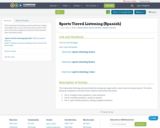
This interpretive listening and presentational writing task aligns with a novice-level unit about sports. This task is tiered by complexity of product (how students show what they know).
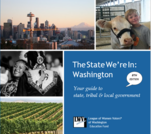
Overview: Seattle Public Schools OER Grant has produced Spanish translations of The State We're In for use in Middle School Spanish Dual Language Immersion Programs. The State We’re In: Washington is an online and printed educational publication written by Jill Severn for the League of Women Voters of Washington Education Fund. Part of a larger Civic Education Project, this instructional resource establishes the link between public participation and effective government. Colorful graphs, historical photos and thought-provoking illustrations help to describe the basics of government, and the connection between a governing authority and culture and economy. Young readers and adults alike will gain a robust sense of past and present tribal governance and their relationship to state and local government in Washington.

Technology Enhanced Elementary Spanish Program - TEESP
World Language Program
Introductory Course for Grades 1 – 6
2007 – 2010
Artwork for lessons created by Evelyn Schluckebier 2008, 2009.
All drawings are copyrighted 2008 with Creative Commons License. Drawings may be
shared but not sold, as long as any derivative works are also shared under a similar
license.
Project evaluation: Lisa Knoche, UNL Research Center
Project funded by Foreign Language Assistance Grant, 2007 - 2010
Program Information
The Technology Enhanced Elementary Spanish Program (TEESP) was a three-year
collaborative effort by ESU #16, ESU #15 and area schools. The program is funded by a
FLAP (Foreign Language Assistance Program) grant.
Project Information
The project design was developed by a team of high school Spanish teachers. Known
as the WLLC team (World Language Learning Community) team these teachers have
worked together for several years to improve the teaching strategies in language
education for area schools. They have all participated in various professional
development opportunities, including Teaching Proficiency through Reading and
Storytelling (TPRS) with Susan Gross and Karen Rowan, Comprehensible Input Reading
Strategies with Jason Fritze and Literacy Strategies delivered by staff from Nebraska
Department of Education, World Languages Department.
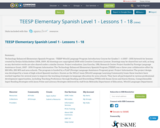
Technology Enhanced Elementary Spanish Program - TEESP
World Language Program
Introductory Course for Grades 1 – 6
2007 – 2010
Artwork for lessons created by Evelyn Schluckebier 2008, 2009.
All drawings are copyrighted 2008 with Creative Commons License. Drawings may be
shared but not sold, as long as any derivative works are also shared under a similar
license.
Project evaluation: Lisa Knoche, UNL Research Center
Project funded by Foreign Language Assistance Grant, 2007 - 2010
Program Information
The Technology Enhanced Elementary Spanish Program (TEESP) was a three-year
collaborative effort by ESU #16, ESU #15 and area schools. The program is funded by a
FLAP (Foreign Language Assistance Program) grant.
Project Information
The project design was developed by a team of high school Spanish teachers. Known
as the WLLC team (World Language Learning Community) team these teachers have
worked together for several years to improve the teaching strategies in language
education for area schools. They have all participated in various professional
development opportunities, including Teaching Proficiency through Reading and
Storytelling (TPRS) with Susan Gross and Karen Rowan, Comprehensible Input Reading
Strategies with Jason Fritze and Literacy Strategies delivered by staff from Nebraska
Department of Education, World Languages Department.
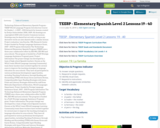
Technology Enhanced Elementary Spanish Program -
TEESP World Language Program Introductory Course for Grades 1 – 6 2007 – 2010
Artwork for lessons created by Evelyn Schluckebier 2008, 2009. All drawings are copyrighted 2008 with Creative Commons License. Drawings may be shared but not sold, as long as any derivative works are also shared under a similar license.
Project evaluation: Lisa Knoche, UNL Research Center Project funded by Foreign Language Assistance Grant, 2007 - 2010 Program Information The Technology Enhanced Elementary Spanish Program (TEESP) was a three-year collaborative effort by ESU #16, ESU #15 and area schools. The program is funded by a FLAP (Foreign Language Assistance Program) grant. Project Information The project design was developed by a team of high school Spanish teachers. Known as the WLLC team (World Language Learning Community) team these teachers have worked together for several years to improve the teaching strategies in language education for area schools. They have all participated in various professional development opportunities, including Teaching Proficiency through Reading and Storytelling (TPRS) with Susan Gross and Karen Rowan, Comprehensible Input Reading Strategies with Jason Fritze and Literacy Strategies delivered by staff from Nebraska Department of Education, World Languages Department.
Project funded by Foreign Language Assistance Grant, 2007 - 2010
Program Information
The Technology Enhanced Elementary Spanish Program (TEESP) was a three-year
collaborative effort by ESU #16, ESU #15 and area schools. The program is funded by a
FLAP (Foreign Language Assistance Program) grant.
Project Information
The project design was developed by a team of high school Spanish teachers. Known
as the WLLC team (World Language Learning Community) team these teachers have
worked together for several years to improve the teaching strategies in language
education for area schools. They have all participated in various professional
development opportunities, including Teaching Proficiency through Reading and
Storytelling (TPRS) with Susan Gross and Karen Rowan, Comprehensible Input Reading
Strategies with Jason Fritze and Literacy Strategies delivered by staff from Nebraska
Department of Education, World Languages Department.
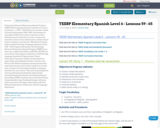
Technology Enhanced Elementary Spanish Program - TEESP
World Language Program
Introductory Course for Grades 1 – 6
2007 – 2010
Artwork for lessons created by Evelyn Schluckebier 2008, 2009.
All drawings are copyrighted 2008 with Creative Commons License. Drawings may be
shared but not sold, as long as any derivative works are also shared under a similar
license.
Project evaluation: Lisa Knoche, UNL Research Center
Project funded by Foreign Language Assistance Grant, 2007 - 2010
Program Information
The Technology Enhanced Elementary Spanish Program (TEESP) was a three-year
collaborative effort by ESU #16, ESU #15 and area schools. The program is funded by a
FLAP (Foreign Language Assistance Program) grant.
Project Information
The project design was developed by a team of high school Spanish teachers. Known
as the WLLC team (World Language Learning Community) team these teachers have
worked together for several years to improve the teaching strategies in language
education for area schools. They have all participated in various professional
development opportunities, including Teaching Proficiency through Reading and
Storytelling (TPRS) with Susan Gross and Karen Rowan, Comprehensible Input Reading
Strategies with Jason Fritze and Literacy Strategies delivered by staff from Nebraska
Department of Education, World Languages Department.
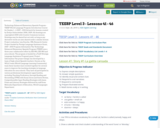
Technology Enhanced Elementary Spanish Program - TEESP
World Language Program
Introductory Course for Grades 1 – 6
2007 – 2010
Artwork for lessons created by Evelyn Schluckebier 2008, 2009.
All drawings are copyrighted 2008 with Creative Commons License. Drawings may be
shared but not sold, as long as any derivative works are also shared under a similar
license.
Project evaluation: Lisa Knoche, UNL Research Center
Project funded by Foreign Language Assistance Grant, 2007 - 2010
Program Information
The Technology Enhanced Elementary Spanish Program (TEESP) was a three-year
collaborative effort by ESU #16, ESU #15 and area schools. The program is funded by a
FLAP (Foreign Language Assistance Program) grant.
Project Information
The project design was developed by a team of high school Spanish teachers. Known
as the WLLC team (World Language Learning Community) team these teachers have
worked together for several years to improve the teaching strategies in language
education for area schools. They have all participated in various professional
development opportunities, including Teaching Proficiency through Reading and
Storytelling (TPRS) with Susan Gross and Karen Rowan, Comprehensible Input Reading
Strategies with Jason Fritze and Literacy Strategies delivered by staff from Nebraska
Department of Education, World Languages Department.